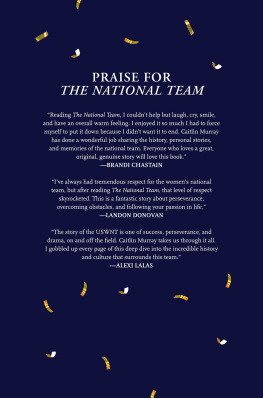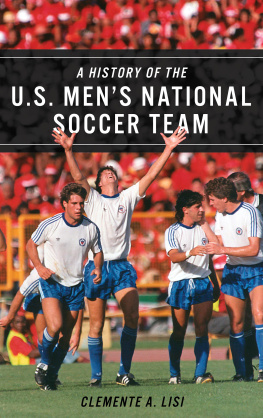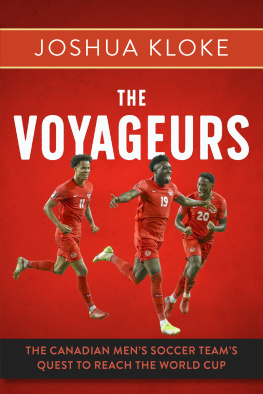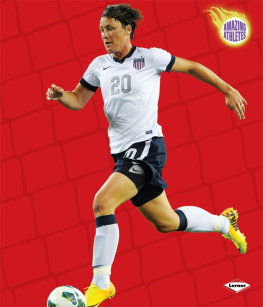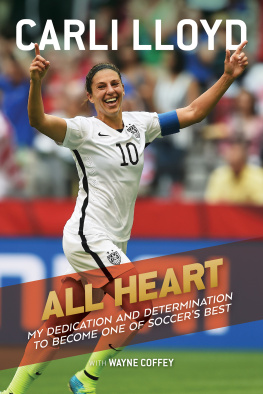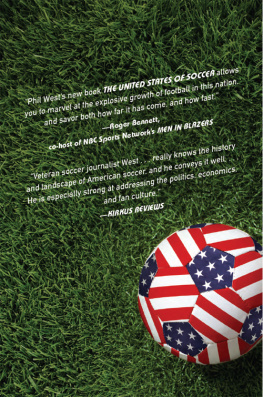
Copyright 2019 Caitlin Murray
Cover 2019 Abrams
Published in 2019 by Abrams Press, an imprint of ABRAMS. All rights reserved. No portion of this book may be reproduced, stored in a retrieval system, or transmitted in any form or by any means, mechanical, electronic, photocopying, recording, or otherwise, without written permission from the publisher.
Library of Congress Control Number: 2018936296
ISBN: 978-1-4197-3449-6
eISBN: 978-1-68335-527-4
Abrams books are available at special discounts when purchased in quantity for premiums and promotions as well as fundraising or educational use. Special editions can also be created to specification. For details, contact specialsales@abramsbooks.com or the address below.
Abrams Press is a registered trademark of Harry N. Abrams, Inc.

ABRAMS The Art of Books
195 Broadway, New York, NY 10007
abramsbooks.com
Contents
PROLOGUE
Where Are All These People Going?
When the national team boarded the bus and got ready to travel to the stadium for a game together, everyone had a different routine.
Some players listened to music on their Walkmans. Kristine Lilly would get so hyped shed need slow, soft music that calmed her down. Kate Markgraf listened to hard-core rap to get pumped up.
Other players, like Mia Hamm and Julie Foudy, sat next to each other and just talked. There was no assigned seating, but Hamm and Foudy always ended up together.
Some players read the newspaper or did a crossword puzzle. Others just zoned out and looked out the window. It was always a quick, uneventful trip.
There was something different about this bus ride, though. Even though the bus had a police escort and was driving on the shoulder of the New Jersey Turnpike, the traffic was so overwhelming that day that the bus could barely navigate the roads.
The players worried they might be late for their game, the opening match of the 1999 Womens World Cup at the New York Giants home stadium.
It was the middle of the day and we left around 11 oclock in the morning, remembers defender Brandi Chastain. All the sudden, were stopped, even though we had an escort. Im wondering, What the heck? Whats going on in New York City thats causing all this traffic?
As the team bus turned a corner, it became clear what was going on. The players could now see that the cars clogging the turnpike had slogans like Go USA! painted in red, white, and blue on the windows. All the cars that dotted the New Jersey Turnpike were filtering into one destination: Giants Stadium.
For the players on that bus looking out the window, it was a sight they never thought theyd see. All those peoplenearly 80,000 of themwere on their way to see the U.S. womens national team play a soccer match.
When we got even closer, we saw tailgate after tailgate, from little girls to adults dressed in red, white, and blue playing pickup games and barbecuing in the parking lot, Chastain says. I remember thinking to myself, This is such a weird moment. It was very surreal.
The teams starting goalkeeper, Briana Scurry, let out a gasp to herself as it dawned on her what was happening.
They were waving at us and taking pictures. We were waving at them and taking pictures of them taking pictures of us, Scurry says, laughing. It was amazing, because we went from, Oh my gosh, where are all these people going? to Were going to be late! to Oh my gosh, these people are here for us!
For a team that not long before had been playing at high school stadiums and not even selling out, the excitement surrounding their first game of the 1999 Womens World Cup was something they couldve never imagined. These were athletes who played on the national team for two primary reasons: They loved soccer, and they wanted to represent their country. Fame, money, and the sort of crowd that was spilling into Giants Stadium were not even remote possibilities in the players minds. Most of the players barely made any money from playing soccer, and no one knew their names. But here they were, watching the crowd gather in droves right before their very eyes.
We were in shock, defender Kate Markgraf says. And I started to get terrified, because thats when I started to understand what it was all about.
This moment, as it turned out, was a big deal. A team that had been used to flying under the radar was about to be the talk of a nation. They were going to set records, inspire a new generation, and change the landscape of sports in America.
It was a moment that caught the national team by surprise, but whether the players realized it or not, they had been preparing for this for years.
PART I
CHAPTER 1
Were Not Very USA-ish
It was almost as if the national came together by accident.
In 1985, there was seemingly little reason for a U.S. womens soccer team to exist. There was no Womens World Cup and no womens soccer in the Olympics, and there were no major trophies on the line.
But there was a group of women who had been pushing to change that. With connections to the U.S. Olympic Committee and the U.S. Soccer Federation, Marty Mankamyer, Betty DAnjolell, and Mavis Derf-linger, among others, pushed decision-makers to take womens soccer seriously. Their goal was for it to one day become an Olympic sport.
We warned them on more than one occasion: You cant brush off recognizing women, Mankamyer remembers.
In the summer of 1985, the perfect opportunity arose for womens soccer to take a leap forward in America. Thats when the National Sports Festival, a sort of mini-Olympics for amateur athletes, would be held in Baton Rouge, Louisiana. Even though womens soccer was still a long way off from becoming an Olympic sport, the Sports Festival organizers decided to give it a chance and include womens soccer for the first time.
A metallurgist from Seattle named Mike Ryan, who coached one of the regional teams there, was approached by officials from U.S. Soccer during the Sports Festival. They wanted him to pick 17 players from those competing at the Festival and coach the U.S. womens national team in its first tournament, which was due to start in Italy in one week.
The U.S. womens national team had existed on paper before thatsome players remember making a list after regional tournaments in 1982, 1983, and 1984but now there was a reason for the team to exist on the field. The national team had its first invitation to play in a real tournament, and U.S. Soccer decided before the Sports Festival that theyd pick a team from the players there.
After the last game, they sat everybody down and said, Were going to pick a national team and the team is going to train in New York and then youll go to Italy. That was the first anybody had ever heard of it, says Ann Orrison, who made the list and eventually played five times for the U.S. team.
The name of Brandi Chastain, a 17-year-old striker from San Jose, California, wasnt on the list. She was there in Baton Rouge too but had far less experience than the college players who made the cut. She also didnt even realize she had missed out on playing for the first national team.
There werent any hard feelings, Chastain says now, 192 appearances for the U.S. later. Honestly, I didnt know anything about it. I had a great time at that tournamentmy parents came, and I had lots of friends there.
The women who did make the list, plucked from the Sports Festival, didnt form a team so much as a mishmash of players. But it was a start.
Next page
